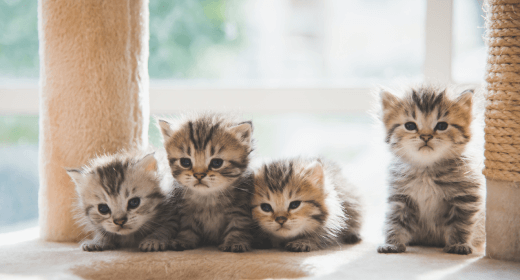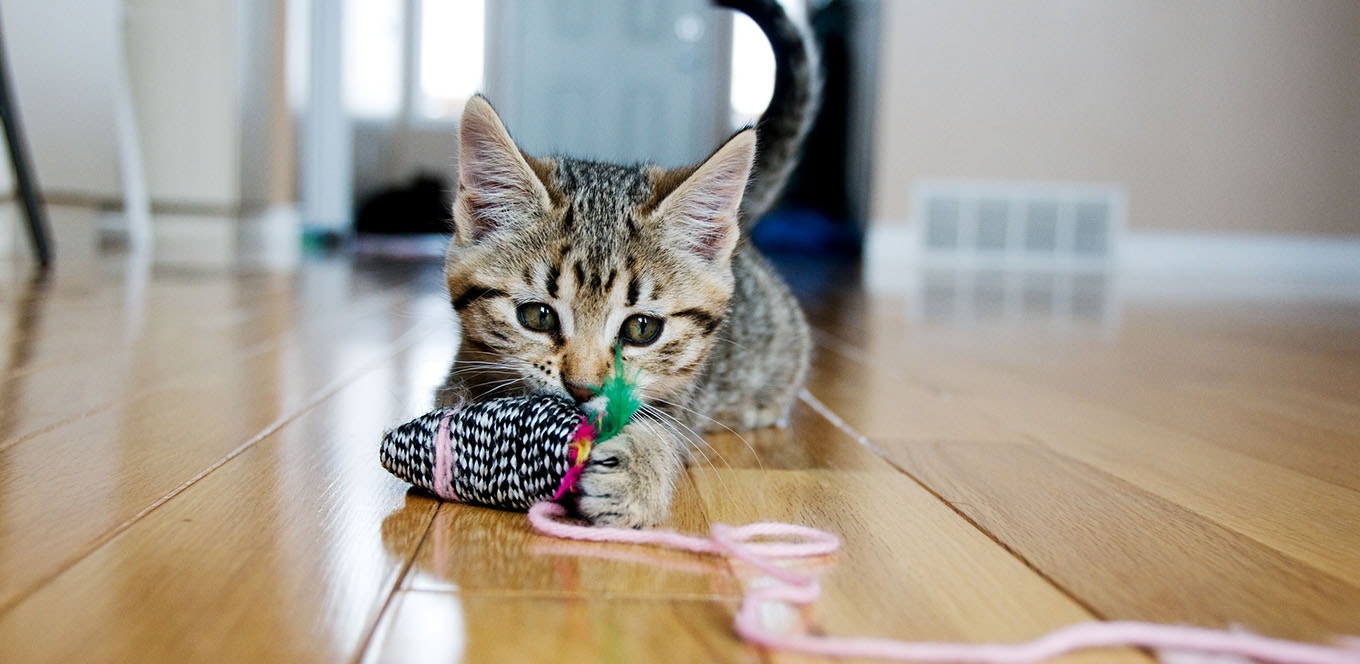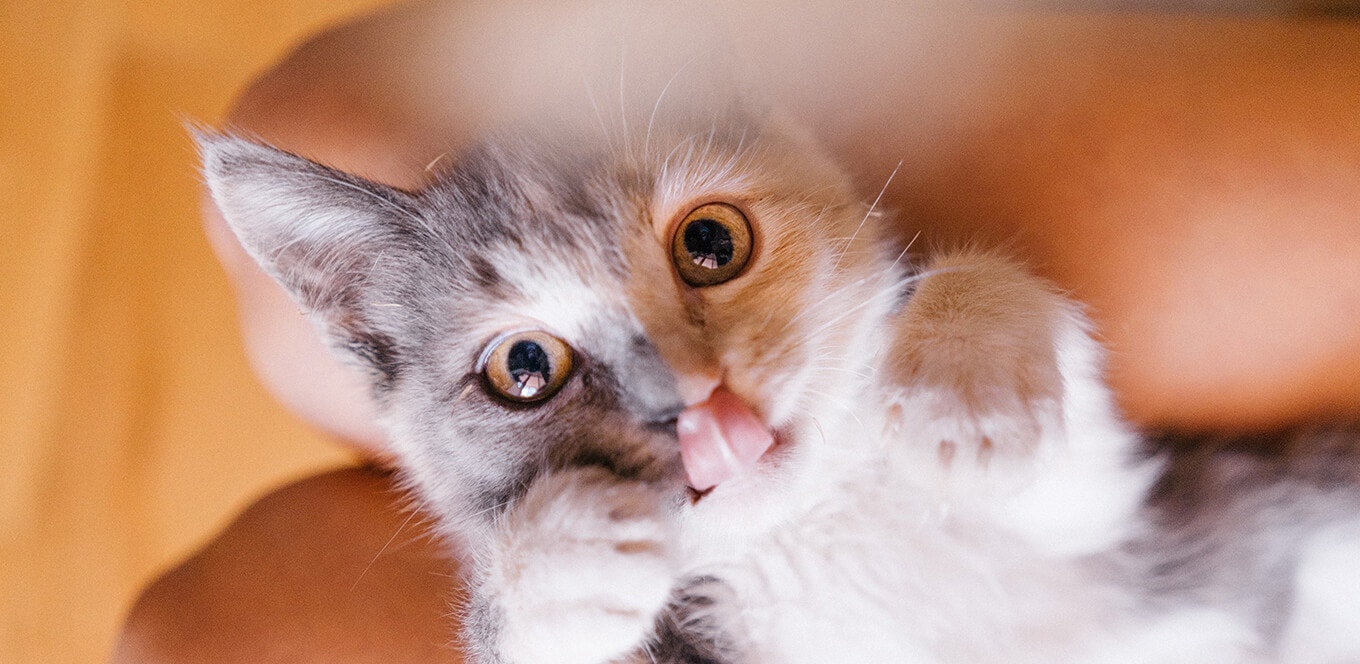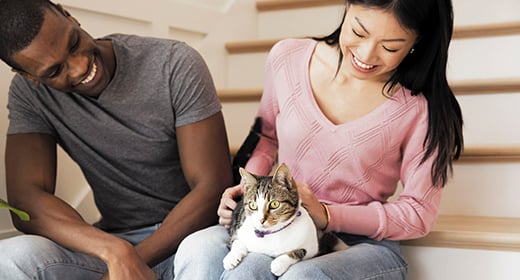

Providing your kitten with the proper nutrition goes way beyond just putting fresh food in a clean bowl. Your kitten’s nutritional needs will change as her body develops through adolescence. Proper nutrition during these critical growth periods will help your kitten mature into a strong, healthy adult cat. Discover four essential kitten-feeding tips you need to know in your kitten’s first year.
Learning what development milestones your kitten will experience in her first year will help you decide what and when to feed her.
After kittens are weaned, they enter a stage of rapid growth, which lasts through the sixth month of life. They need a balanced diet to deliver the nutrients and energy to sustain such rapid development.
Kittens have twice the energy needs of adult cats on a pound-per-pound basis. But their smaller mouths, teeth and stomachs limit the amount of food they can digest during a single meal. Therefore, it may be best to divide their total daily food amount into three or four smaller meals.
Because every bite must be packed with nutrition, kittens require a diet specifically formulated for growth. The best choice is a food with animal-based proteins that is highly digestible, nutrient dense and designed to meet kittens’ unique nutritional needs.
As kittens approach adult size, their nutritional requirements begin to change again. Their rate of growth begins to slow, activity levels may decline and they can start eating fewer, larger meals each day. During this stage, kittens begin to look like adults, but they are still growing and need the special nutrition found in kitten food.
The adolescent growth stage is a time when many cat owners are tempted to change a kitten’s food for variety. But cats do not get bored with a consistent diet of high-quality dry food. You can supplement your kitten’s dry food with a nutrient-dense canned food for a nutritious change of pace.
When your cat is about 12 months old, it’s time to switch to a maintenance formula adult cat food, such as IAMS™ ProActive Health™ Healthy Adult with Chicken. At this age, cats no longer need the extra calories and nutrients for growth supplied by kitten food. As with any change in a cat’s diet, remember to gradually transition from kitten food to adult food over a period of several days.
Monitor your cat’s weight and body condition during the transition, and adjust feeding portions if necessary. Because cats generally eat only what they need, free-choice feeding is fine for most cats. However, some indoor cats that don’t exercise much may overeat if fed free choice. In this situation, portion-controlled feeding twice a day is a good alternative.
Giving a kitten “human food” and table scraps can lead to undesirable behaviors, such as begging or stealing food. Feeding homemade diets or food formulated for adult cats (especially those designed for weight loss), or supplementing a complete and balanced diet with vitamins could cause nutritional disorders.
Kittens and cats are strict carnivores and need the nutrients found in meat. For example, sufficient amounts of taurine, an essential amino acid provided naturally through meat, help cats maintain healthy eyes, heart and reproduction. All IAMS kitten and cat food formulas have optimal levels of taurine for every life stage.




Since most feline creatures do not like water, bathing a kitten can seem to be a daunting task. Yet, as a cat parent, you cannot give up. You must bathe your kitty, especially to desensitise them to the experience and prevent skin problems. However, most first-time cat parents do not know how to get started with bathing their kittens. If you are one of them, fret not! With patience and a gentle approach, you can turn bathing time into a positive experience for your feline friend. So, read on! This article takes a deep dive into how to bathe a kitten.
Before you go on to bathing your kitten, do not forget to trim its nails. Feline creatures do not hesitate from clawing anyone or anything that triggers discomfort in them. Not even their own caregivers. Similarly, there are multiple other things you must ensure while bathing your kitten. Let's explore them in brief:
Brush your kitten's fur
Kittens shed all year long. Like humans, they might shed in excess while bathing, and that might clog your draining system. Hence, it's best to brush your kitty's fur thoroughly to get rid of the loose fur before you place it in the bathtub.
Pick the right time
Your kitten is going to oppose the bathing time with full force when it is highly energetic. However, when it is tired and exhausted, your pet might just let you do your thing. So, bathe your newborn kitty after tiresome activities like playtime, exercise, etc.
Use a kitten-specific shampoo
When bathing your kitty, go for a bottle of shampoo that is specifically developed for cats. And avoid shampoos used by humans at all costs. As cats groom themselves, chances are that they may ingest some shampoo residue left on their fur.
Rinse thoroughly
Use a cup or small container to rinse off the shampoo from your kitten’s fur, ensuring that water doesn’t get into its ears, nose, or eyes. Since you want your kitty to feel comfortable during the bathing session, avoid using extremely hot or cold water. Instead, go for a few degrees above lukewarm. Moreover, run your fingers through its coat to evenly distribute the water.
Shower your kitten with treats
When you are done bathing your kitten, reward it with treats immediately. Playtime and treats can help your feline friend resonate bathing time with fun moments. Treats can also come in handy to distract your pet if it starts to get anxious.
Every time you bathe your kitty, you must dry it thoroughly. In fact, it is one of the most important aspects of learning how to wash a kitten as damp fur can lead to skin problems. However, you do not want to vigorously rub a towel on your pet’s fur. It will only cause discomfort and irritation. Since bathing is a stressful experience for most kitties, you need to be extra careful while drying their fur up. So, here’s a step-by-step guide on drying your kitten’s coat:
Step 1: Place your kitten on a clean and dry towel.
Step 2: Wrap your kitty in the aforesaid towel.
Step 3: Sit on a chair with your pet on your lap and allow it to calm down.
Step 4: Press the towel gently against your kitten’s fur to get rid of excess water.
Step 5: Continue to press dry your kitty’s fur until its damp and not soaking wet.
Cats and kittens have an aversion to water due to their ancestral history. These feline creatures were once desert-dwelling animals, which means they rarely encountered rains, lakes, or rivers. Hence, all types of water – except drinking water – is alien to them. And that’s probably why your fur baby tries to resist the bathing session. However, being gentle with your little kitty can prevent issues and make the whole experience a little comfortable for it. Moreover, do not submerge your furry friend under running water and keep its bath time as short as possible.
Note: If your kitten continues to show extreme distress during bath time, consult a veterinarian.
Now that you know how to bathe a kitten, go on and help your pet groom. The time spent bathing your kitty provides you two with an opportunity to establish an unbreakable bond. Moreover, it will familiarise your kitten with your touch, fostering trust and strong cat-owner relationship.